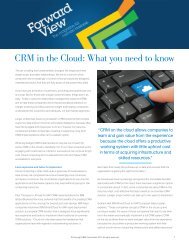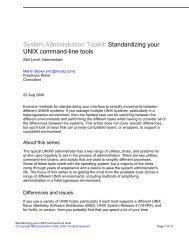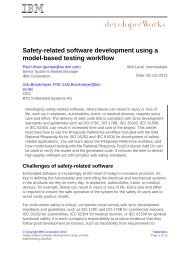Virtual Worlds, Real Leaders: - IBM
Virtual Worlds, Real Leaders: - IBM
Virtual Worlds, Real Leaders: - IBM
You also want an ePaper? Increase the reach of your titles
YUMPU automatically turns print PDFs into web optimized ePapers that Google loves.
®<br />
<br />
INTERNATIONAL BUSINESS MACHINES CORPORATION<br />
NEW ORCHARD ROAD, ARMONK, NY 10504<br />
© International Business Machines Corporation 2007<br />
All Rights Reserved<br />
SERIOSITY, INC.<br />
2370 WATSON CT., SUITE 110, PALO ALTO, CA 94303<br />
<strong>Virtual</strong> <strong>Worlds</strong>,<br />
<strong>Real</strong> <strong>Leaders</strong>:<br />
Online games put the future of<br />
business leadership on display<br />
A Global<br />
Innovation<br />
Outlook<br />
2.0 Report
“ If you want to see what<br />
business leadership may look<br />
like in three to fi ve years,<br />
look at what’s happening<br />
in online games.”<br />
— Byron Reeves, Ph.D.,≠ the Paul C. Edwards Professor of Communication<br />
at Stanford University and Co-founder of Seriosity, Inc.<br />
GIO 2.0 Report<br />
1
2<br />
Game On<br />
As the business world becomes<br />
more distributed and virtual,<br />
do online games offer lessons<br />
on the future of leadership?
What’s next? It’s the simple question that<br />
businesses spend millions trying to answer<br />
every year, all with the goal of learning what<br />
the business world of the future will look<br />
like. But there are some elements of this<br />
future that are already falling into place.<br />
For example, we know that business is becoming<br />
increasingly global. We know that enterprises<br />
are increasingly distributed, faster paced,<br />
and fi ercely competitive. And we know that<br />
more work will be conducted virtually, using<br />
technology to bridge previously impassable<br />
communications gaps.<br />
All of which begs certain questions: What new skills<br />
and competencies will leaders need to succeed in work<br />
environments that are increasingly virtual and distributed?<br />
What types of training and tools can forward-thinking<br />
companies use to enable a new breed of leader that thrives<br />
in these uncertain environments? Are there people who<br />
already have these skills, or places where these new skills are<br />
being developed and refi ned?<br />
Online games, and specifi cally massively multiplayer<br />
online role-playing games (MMORPGs), offer a glimpse at<br />
how leaders develop and operate in environments that are<br />
highly distributed, global, hyper-competitive, and virtual.<br />
MMORPG:<br />
Massively multiplayer<br />
online role-playing<br />
games.<br />
GIO 2.0 Report<br />
3
4<br />
“ You can never stop earning<br />
the right to be their leader.”<br />
— Tom Cadwell, MBA student at Kellogg School<br />
of Management and former employee at<br />
Blizzard Entertainment, the maker of World of Warcraft<br />
“You always have to be<br />
sensitive to the concerns of<br />
members, and you always<br />
have to sell decisions you make .<br />
Goodwill from past successes<br />
doesn’t last forever.”
Hundreds of thousands of players — sometimes millions —<br />
interact daily in highly complex virtual environments.<br />
These players self-organize, develop skills, and settle into<br />
various roles. <strong>Leaders</strong> emerge that are capable of recruiting,<br />
organizing, motivating, and directing large groups of players<br />
toward a common goal. And decisions are made quickly,<br />
with ample, but imperfect, information. Sound familiar?<br />
“MMORPGs mirror the business context more than you<br />
would assume,” says Byron Reeves, Ph.D., the Paul C.<br />
Edwards Professor of Communication at Stanford University<br />
and Faculty Director of the Stanford Media X Partners<br />
Program. “They presage one possible future for business —<br />
one that is open, virtual, knowledge-driven, and comprised<br />
of a largely volunteer or at least transient workforce.”<br />
Of course, online games do not provide a perfect analog<br />
for the business world of the future. The stakes in the real<br />
world are obviously much higher. But it’s easy to see how<br />
some of the qualities of gifted gaming leaders could translate<br />
into a corporate setting. The collaborative infl uence that<br />
online leaders exhibit is extraordinary in some cases. Gaming<br />
leaders are more comfortable with risk, accepting failure,<br />
and the resulting iterative improvement, as part of their<br />
reality. Many of these leaders are able to make sense of<br />
disparate and constantly changing data, translating it all<br />
into a compelling vision. And the relationship skills<br />
of the best gaming leaders would put many Fortune 500<br />
managers to shame.<br />
“You can never stop earning the right to be their leader,”<br />
says Tom Cadwell, an MBA student at Kellogg School of<br />
Management and former employee at Blizzard Entertainment,<br />
the maker of World of Warcraft. “You always have to be<br />
sensitive to the concerns of members, and you always have<br />
to sell decisions you make. Goodwill from past successes<br />
doesn’t last forever.”<br />
WORLD OF<br />
WARCRAFT:<br />
An MMORPG<br />
with over 8 million<br />
players worldwide.<br />
GIO 2.0 Report<br />
5
6<br />
In a survey of <strong>IBM</strong>’s own internal gaming community,<br />
which includes more than 200 gamers, nearly half believe<br />
that game playing is improving their “real world” leadership<br />
capabilities; and four out of 10 say they have already applied<br />
MMORPG leadership techniques and approaches to<br />
improve their leadership effectiveness at work.<br />
But the lessons that can be learned from MMORPGs<br />
don’t stop there. While studying the personal attributes of<br />
online game leaders is useful, perhaps more important is<br />
the role the environment plays in their development. Many<br />
of the qualities of online game environments facilitate<br />
leadership, and speed up the process of identifying leaders.<br />
Most games make each player’s capabilities openly known,<br />
which eliminates much of the guesswork when assigning<br />
roles. They offer clear economies that provide for easily<br />
understood incentive programs. And the communications<br />
channels that are utilized by online gaming leaders are more<br />
sophisticated and varied than those in most workplaces.<br />
While these games attract players of all ages, the fi rst<br />
generation that grew up navigating these environments<br />
is beginning to enter the workforce in earnest, and managers<br />
will need to adjust their styles accordingly. Winning in<br />
business will require enterprises to fully understand how<br />
these games are shaping the next generation of leaders<br />
and to apply those learnings to their own operations.
THE UNSIGHTLY ACRONYM<br />
What are MMORPGs, anyway?<br />
The not-so-short answer is: massively multiplayer online<br />
role-playing games. For the purposes of the discussion<br />
that follows in this report, however, we’ll simply refer to this<br />
mouthful as “online games.” But there are important<br />
distinctions between just any game that can be played<br />
online and MMORPGs.<br />
MMORPGs are a unique and evolving area of online<br />
entertainment. They can bring together millions of<br />
different players who assume digital personalities known<br />
as avatars. Within these online games, each of which<br />
is constructed with different rules and goals, players<br />
interact with each other, form relationships, join guilds<br />
or in-game corporations, and carry out complex and<br />
collaborative missions. Some of the more popular games<br />
include World of Warcraft, Eve Online, and EverQuest.<br />
<strong>Virtual</strong> social worlds, like Second Life, share many of the<br />
same characteristics as MMORPGs, and can develop<br />
leadership capabilities as well. But for the purposes of<br />
this discussion, we will be focused primarily on online<br />
games in which there are set goals and motivating factors.<br />
AVATAR:<br />
A player’s online<br />
character.<br />
GUILD:<br />
A popular term<br />
for a group of<br />
characters working<br />
together towards<br />
a common goal.<br />
GIO 2.0 Report<br />
7
8<br />
Serious Gaming<br />
The what, why, and how of the<br />
gaming and leadership study.
Inspired by fi ndings from the Global Innovation Outlook 2.0,<br />
<strong>IBM</strong> decided to delve deeper into these increasingly popular<br />
virtual worlds and to research whether real business lessons<br />
can be learned from observing leadership in online games.<br />
Working with a group of GIO participants, domain<br />
experts and leaders from <strong>IBM</strong>’s Research, Center for<br />
Advanced Learning, and Executive Development organizations<br />
outlined the primary focus area and key research<br />
questions to be explored in mid-2006. Consistent with the<br />
increasingly open and collaborative nature of innovation<br />
itself, <strong>IBM</strong> partnered with Seriosity, Inc., a software company<br />
that develops enterprise products and services inspired<br />
by online games, to refi ne and execute this unique research.<br />
The subsequent study provided the basis for many of the<br />
fi ndings in this report. 1<br />
The study was led by Byron Reeves, Professor of<br />
Communication at Stanford University and co-author of<br />
The Media Equation: How People Treat Computers, Television<br />
and New Media Like <strong>Real</strong> People and Places (Cambridge<br />
University Press); and Thomas Malone, the Patrick J.<br />
McGovern Professor of Management at the MIT Sloan<br />
School of Management, Founder and Director of the<br />
MIT Center for Collective Intelligence, and author of<br />
The Future of Work: How the New Order of Business Will<br />
Shape Your Organization, Your Management Style, and Your<br />
Life (Harvard Business School Press, 2004). Both are<br />
board members of, and advisors to, Seriosity.<br />
GIO 2.0 Report<br />
9
10<br />
The strategy for examining games was both inductive<br />
and deductive. The goal of this dual approach was to roam<br />
freely within the online gaming domain looking for<br />
leadership moments and strategies, but also to be directed<br />
by a comprehensive model of leadership when making<br />
comparisons to real world behaviors.<br />
The model selected to guide the analysis was developed<br />
by Deborah Ancona, Thomas Malone, Wanda Orlikowski,<br />
and Peter Senge at the MIT Sloan School of Management.<br />
The Sloan <strong>Leaders</strong>hip Model breaks leadership qualities and<br />
action into four parts: Visioning, Sense-making, Relating,<br />
and Inventing. This model has been described in a number<br />
of publications (most notably Harvard Business Review’s<br />
February 2007 article “In Praise of the Incomplete Leader”),<br />
and has been used as a basis for MIT workshops on<br />
distributed leadership.<br />
With the Sloan <strong>Leaders</strong>hip Model as a guide,<br />
the study captured over 50 hours of in-world activity from<br />
fi ve different games that were most representative in<br />
demonstrating leadership behavior in action. The team<br />
also reviewed 173 anonymous online surveys covering<br />
leadership in online gaming and conducted 10 one-hour<br />
interviews with prominent gaming leaders.<br />
The researchers found all four elements of the Sloan Model<br />
were readily apparent in online game leaders, and this<br />
provided one aspect of the framework for the conclusions<br />
that were drawn.<br />
Finally, a team from <strong>IBM</strong>’s Institute for Business Value<br />
(IBV) built upon this research and surveyed <strong>IBM</strong>’s <strong>Virtual</strong><br />
Universe Community to better understand how successful<br />
leaders behave in online games and what aspects of the<br />
game environment leaders use to enable guild success.
Number of<br />
online gamers worldwide: 7<br />
73 MILLION<br />
Average age<br />
of online gamers: 6<br />
27<br />
Game Player Gender: 5<br />
MALE<br />
56%<br />
43%<br />
FEMALE<br />
QUICK FACTS<br />
“<strong>Real</strong>” money spent in 2006 by<br />
game players to acquire virtual assets<br />
or insights from other players: 4<br />
$1 BILLION<br />
Rate at which MMORPG<br />
economies are growing: 1<br />
36.5% (CAGR)<br />
��<br />
�<br />
�<br />
���� ���� ���� ���� ����<br />
GIO 2.0 Report<br />
Distribution of age: 2<br />
50+
12<br />
Making <strong>Leaders</strong><br />
from Lemmings<br />
Environmental factors can<br />
facilitate leadership in otherwise<br />
reticent employees.
It’s the classic nurture versus nature debate.<br />
Are leaders born or are they made? There are compelling<br />
arguments to be made for both. But even the most die<br />
hard behaviorists would likely agree that by the time an<br />
individual reaches adolescence, leadership potential<br />
is either there, or it’s not.<br />
However a close look at leadership in online games tells<br />
a different story. Using massively multiplayer online games as<br />
a template, it can be argued that leadership is as much a<br />
by-product of environment as it is intrinsic.<br />
<strong>Leaders</strong>hip happens quickly and easily in online games,<br />
often undertaken by otherwise reserved players, who surprise<br />
even themselves with their capabilities (see The Need to<br />
Lead, page 18). There is no reason to think that the same<br />
cannot be done in corporate settings of various sizes,<br />
missions, and markets.<br />
However, this is not to say that every person within an<br />
organization can and should lead, but simply that if given<br />
the right tools in the right circumstance, leadership can<br />
emerge. And in working environments that are increasingly<br />
project-oriented, more leaders could yield better effi ciency.<br />
Three of every four players<br />
surveyed in the <strong>IBM</strong> study <strong>Leaders</strong>hip happens quickly and<br />
believe that the techniques easily in online games, often<br />
and approaches found in undertaken by otherwise reserved<br />
online games could enhance players, who surprise even<br />
their leadership effective-<br />
themselves with their capabilities.<br />
ness in the workplace.<br />
So what is it about these gaming environments that<br />
make leaders out of lemmings? For starters, there are many<br />
opportunities to lead. Online games are very iterative.<br />
GIO 2.0 Report<br />
13
14<br />
RAID:<br />
A guild effort in<br />
war-oriented games<br />
that involves<br />
strategizing, attacking,<br />
and eventually<br />
toppling an enemy.<br />
While there is an overriding goal of the group, there are a<br />
series of raids or missions that make up the journey, each of<br />
which requires leadership of player groups of varying size.<br />
Spreading around the leadership wealth in this way provides<br />
the opportunity for many players to try on leadership roles,<br />
decide if leadership agrees with them, and pursue it further<br />
if so inclined. Also, there is no expectation of permanence<br />
in these leadership roles, an important factor that encourages<br />
experimentation (see Impermanent Power, page 22).<br />
Three of every four players surveyed<br />
in the <strong>IBM</strong> study believe that the<br />
techniques and approaches found in<br />
online games could enhance their<br />
leadership effectiveness in the workplace .<br />
INCENTIVE<br />
SYSTEMS:<br />
Approaches used in<br />
online games<br />
to motivate and<br />
reward players<br />
based on performance<br />
and willingness<br />
to take risks.<br />
“I was approached by<br />
several friends to assume<br />
leadership of the guild, and<br />
agreed even though I was<br />
uncertain of my suitability,”<br />
says one guild leader. “I’ve<br />
grown more accustomed<br />
now to directing various aspects of running the guild and<br />
providing a vision and leadership to the members. Follow-up<br />
and assertiveness now feel more natural to me, even in<br />
real life. It has been an amazing opportunity to push myself<br />
beyond my boundaries.”<br />
Players in online games are also given tools that make<br />
leadership easier. The skills and competency levels of each<br />
member of a guild are readily apparent to a potential leader,<br />
making delegation a relatively straightforward task. And risk<br />
assessment tools provide real-time information in advance of<br />
any action, a luxury any corporate manager would love to have.<br />
The incentive systems that are used to motivate players are<br />
also openly available, which facilitates trust and credibility<br />
among players. This transparency of information is directly<br />
related to the Sensemaking element of the Sloan Model,
The skills and competency<br />
levels of each guild member are<br />
readily apparent to a potential<br />
leader, making delegation a<br />
relatively straightforward task.<br />
GIO 2.0 Report<br />
15
16<br />
in which leaders are able to understand the context of the<br />
world in which they are operating. It also breeds confi dence<br />
in potential leaders, and reduces the guesswork in<br />
decision-making.<br />
“Some tools that can foster this kind of confi dence<br />
have emerged in business environments, with the adoption<br />
Instant messaging, online chats,<br />
web site forums, and voice over<br />
IP (VoIP) are just a few of the different<br />
communications mediums that<br />
are utilized over the course of a game.<br />
of business intelligence<br />
software that helps<br />
make sense of disparate<br />
information,” says<br />
Jim Sphorer, Director,<br />
<strong>IBM</strong> Research. “But<br />
there is also an opportunity<br />
to improve risk assessment (trending) software, and more<br />
transparent incentive and skill rating systems likely would be<br />
a signifi cant step forward in most enterprises.”<br />
Finally, the multiple levels of communication within<br />
the online gaming world give leaders many options when<br />
it comes to communicating with their direct reports. The<br />
Sloan Model refers to this as Relating, the act of developing<br />
key relationships within and across organizations. As a guild<br />
leader, mediating confl ict and maintaining relationships is an<br />
important part of the job. As with companies, the personal<br />
dynamics of guilds can interfere with the mission of the group.<br />
Stanford University Ph.D. student and Seriosity<br />
consultant Nick Yee studied this phenomenon as part of his<br />
research for The Daedalus Project, an ongoing study of online<br />
gamers (http://www.nickyee.com/daedalus/). “In any<br />
situation where people have different needs and motivations,<br />
confl icts will arise,” writes Yee. “Inevitably, the guild leader<br />
will be asked to become the mediator.” He goes on to say<br />
that confl ict mediation can be time-consuming and, quite<br />
often, petty.
But through the use of various communications mediums,<br />
leaders can keep the mediation to a minimum. Instant<br />
messaging, online chats, web site forums, and voice over<br />
IP (VoIP) are just a few of the different communications<br />
mediums that are utilized over the course of a game. Each<br />
medium serves a specifi c purpose. For example, when<br />
communicating changes in the incentive system that affects<br />
the entire organization, a post to the online forum would<br />
be appropriate. When discussing a personality confl ict with a<br />
player, perhaps a dedicated online chat would be preferred.<br />
When conducting a raid, real-time VoIP may be needed.<br />
In very complex or involved raids or missions, a leader may<br />
in fact use broadcast (VoIP), narrowcast (group IM), and<br />
microcast (IM) simultaneously to move the group toward<br />
their objective. The more methods of communication a<br />
leader has, the more opportunity exists to lead effectively.<br />
In Summary:<br />
Online gaming environments facilitate<br />
leadership through:<br />
1. Project-oriented organization<br />
2. Multiple real-time sources of information<br />
upon which to make decisions<br />
3. Transparent skills and competencies<br />
among co-players<br />
4. Transparent incentive systems<br />
5. Multiple and purpose-specifi c<br />
communications mediums<br />
GIO 2.0 Report<br />
17
The Need to Lead<br />
The story of one gamer’s<br />
unexpected rise to management.
Helen Cheng got her fi rst taste of online gaming three<br />
years ago, when a friend invited her to join up with<br />
Star Wars Galaxies, a game modeled after the epic movies.<br />
“I was pretty skeptical,” she recalls. “I mean, fi ghting<br />
dragons in a fantasy world? Sounds kind of nerdy.”<br />
It took three days and Cheng was hooked. And her<br />
opinion of online gaming has changed considerably since then.<br />
It wasn’t long before Cheng moved on to World of<br />
Warcraft, an online game that counts more than 8 million<br />
members. She quickly moved up the ranks of the game, and<br />
spent six months as a level 60 guild leader, the highest level<br />
of leadership in the game. Here are some of the leadership<br />
lessons Cheng, a Stanford graduate, took away from her<br />
gaming experience.<br />
Q: Do you consider yourself a natural leader?<br />
CHENG: No. I’m a pretty quiet person, actually.<br />
The fi rst time I thought that I could be a leader<br />
was during a raid that involved 40 people. The raid<br />
went bad, and everybody died. The designated<br />
raid leader went silent. Everyone was waiting around for<br />
instruction, and the leader was just stewing. Finally, I pushed<br />
my button to talk and rallied the troops to revive one another<br />
and try again, mostly because I didn’t know what else to do. It<br />
was me, this girl, talking to a room of 39 guys. And to my shock<br />
and surprise, everyone complied and we got going. That was a<br />
defi ning moment for me, and eventually led to me becoming a<br />
guild leader.<br />
GIO 2.0 Report<br />
19
20<br />
Q: What was it about the environment that<br />
made it easy for you to try on a leadership role?<br />
CHENG: The speed at which things happen<br />
contributes a great deal to that. You don’t have a lot<br />
of time, and decisions have to get made. Also, there<br />
are so many different forms of commu nication.<br />
You can send instant messages to anyone, or use<br />
a chat channel to communicate with your guild, or speak over<br />
voice over IP connection, even leave messages on the web<br />
site forum. These different communications mediums afford<br />
more opportunities to lead.<br />
Also, the way a particular game is designed has a huge bearing<br />
on how easy it is to lead. There are decisions that the designer<br />
makes, like how many people will be needed for a particular<br />
raid, that will have an effect on leadership roles. If a guild<br />
leader has to build a team of 70 or 80 people, that’s a recruiting<br />
challenge, and it requires a complex incentive system to<br />
motivate the guild. But if you only need 20 or 30 members in a<br />
guild, it provides more opportunity for leadership. The point is,<br />
you can change a simple mechanic within the game, and it has<br />
lasting effects on leadership.<br />
Q: What is it like managing people that you<br />
never see in person?<br />
CHENG: Not that different from real life. I’ve had<br />
my share of personality confl icts that I had to<br />
mediate. In my last guild, we had a raid offi cer that<br />
was extremely capable and knowledgeable. He<br />
was great at leading 40-man raids in real time. But he was
“ Finally, I pushed my button to talk<br />
and rallied the troops to revive<br />
one another and try again, mostly<br />
because I didn’t know what else<br />
to do. It was me, this girl, talking to a<br />
room of 39 guys. And to my shock<br />
and surprise, everyone complied and<br />
we got going. That was a defi ning<br />
moment for me, and eventually led to<br />
me becoming a guild leader.”<br />
— Helen Cheng, Level 60 Guild Leader and Stanford graduate<br />
extremely practical, and did not care about other guild members’<br />
feelings, or guild unity. On the other hand, we had a recruiting<br />
offi cer that was very friendly. He was very gung ho about building<br />
relationships. They often went head-to-head on issues. And I<br />
found it very diffi cult to mediate between them. So eventually I left<br />
to go raid with another guild that was more advanced.<br />
Q: Kind of like climbing the corporate ladder?<br />
CHENG: Something like that.<br />
GIO 2.0 Report<br />
21
22<br />
Impermanent Power<br />
Contrary to traditional management strategy,<br />
business leadership roles can be temporary.
GIO 2.0 Report<br />
There is an unspoken understanding among those<br />
well-versed in management technique that once a strong<br />
leader has been identifi ed, that person should be installed as<br />
a manager, regularly promoted based on performance, and<br />
given a steadily increasing amount of responsibility over an<br />
indefi nite period of time.<br />
Of course, this organizational strategy has come under<br />
criticism in the past, mostly because, as the Peter Principle<br />
succinctly states, it’s a good<br />
way to elevate an employee <strong>Leaders</strong>hip roles are more ephemeral,<br />
to the level of their incom- lasting 10 minutes, 10 days, or even<br />
petence. For instance, it months at a time. <strong>Leaders</strong>hip is seen as<br />
should not be assumed that a job that needs to be assumed in order<br />
just because an employee has to get a specifi c task done, not an identity<br />
demonstrated an aptitude<br />
that follows a player around forever.<br />
for leadership in one set of<br />
circumstances, that same person will be an effective leader<br />
in all circumstances.<br />
That’s where the world of online games has the potential<br />
to teach the business world a strong lesson. In many online<br />
games, there is no expectation about permanence of roles.<br />
<strong>Leaders</strong>hip roles are more ephemeral, lasting 10 minutes,<br />
10 days, or even months at a time. <strong>Leaders</strong>hip is seen as a<br />
job that needs to be assumed in order to get a specifi c task<br />
done, not an identity that follows a player around forever.<br />
This “temporary leadership” emerges as a result of<br />
the pace of play, and the project-oriented nature of online<br />
games. Because decisions need to be made quickly, and<br />
the cast of characters present during any given session<br />
is constantly changing, leaders are chosen quickly, on<br />
the basis of experience and skills suited to the task at hand.<br />
23
24<br />
The analog in the Sloan Model is Inventing, where leaders<br />
design new ways of working together to realize a vision.<br />
Those leaders do not<br />
That means not just promoting leaders expect to continue to lead<br />
that are fl exible, but having the the group beyond that<br />
option of swapping leaders in and out , particular mission, and they<br />
depending on the task, the time understand the very real<br />
frame of a project, and the skill sets of possibility that tomorrow,<br />
they will be followers. And<br />
the available team members.<br />
decisions on who will lead<br />
and who will follow are made organically, by the group itself,<br />
rather than coming from some higher authority.<br />
The implications of this for corporate settings are obvious.<br />
Given the rapid pace of change in today’s global business<br />
environment, the need for this kind of leadership fl exibility<br />
is apparent.<br />
That means not just promoting leaders that are fl exible,<br />
but having the option of swapping leaders in and out,<br />
depending on the task, the time frame of a project, and the<br />
skill sets of the available team members.<br />
That is not to say that long-term leadership stars don’t<br />
and shouldn’t emerge in this environment. Some gamers (and<br />
certainly business managers) with exceptional relationship<br />
skills are able to build effective teams, delegate leadership<br />
responsibilities to their lieutenants, and keep a large group<br />
of direct reports moving in the right direction for extended
periods of time. In the Sloan Model, this is called Visioning,<br />
or the ability to create a compelling vision of the future.<br />
Some leaders yearn for this kind of role, and fi ght to hold<br />
on to it. But for others, leadership can be tiring and lead to<br />
burnout. Especially during trying times. One gaming leader<br />
that was interviewed in the study found himself dealing with<br />
interpersonal confl icts for several hours each night. He created<br />
an alternate character so that he could play without acting<br />
as a mediator of disputes. That scenario lends itself to dynamic,<br />
shifting roles of leadership that continually change as a<br />
group develops.<br />
In Summary:<br />
In fast moving distributed environments,<br />
leadership can be:<br />
1. A temporary phenomenon<br />
2. Task-oriented<br />
3. Dynamic and constantly changing<br />
GIO 2.0 Report<br />
25
26<br />
The Freedom to Fail<br />
Risk-taking and the ability to make decisions<br />
quickly are critical leadership skills.
Some elements of the online gaming world, like its<br />
project-oriented structure or the transparency of skills<br />
and incentives, are relatively easy to replicate in business<br />
environments. Others, like the inherent tolerance for<br />
risk in games, are far more challenging to implement when<br />
it comes to the real world.<br />
But the issue of risk tolerance is highly relevant in today’s<br />
fast-paced business environment, one in which rapid turns<br />
of innovation can mean the difference between fi nancial<br />
success and failure. Businesses of all sizes, but especially big<br />
ones, struggle mightily with the need to evolve quickly<br />
and out-innovate their competition. Ironically, embracing<br />
risk in the enterprise is itself<br />
a considerable risk. There is<br />
an ingrained fear of failure<br />
that holds many corporate<br />
employees back when it<br />
comes to taking big risks<br />
In the online gaming world,<br />
risk-taking is encouraged. It is<br />
even considered a necessary<br />
precursor to success.<br />
that could yield big rewards. Online gamers do not share this fear.<br />
In the online gaming world, risk-taking is encouraged.<br />
It is even considered a necessary precursor to success.<br />
<strong>Leaders</strong> formulate strategies quickly, with imperfect data,<br />
and put their strategy into motion without fear of consequences.<br />
Yes, it is only a game. And more often than not there is no<br />
real money (and certainly not life) on the line.<br />
But to assume that there is nothing ventured would be a<br />
mistake. Many games have severe penalties for failure. These<br />
setbacks can range from time-wasted to squandered status,<br />
all of which affect the enjoyment of the game. Millions of<br />
dollars are not riding on each raid, but try telling a hardcore<br />
gamer that failure doesn’t matter.<br />
GIO 2.0 Report<br />
27
28<br />
There is another reason risk is tolerated in online games.<br />
The structure of the games is such that failure is accepted<br />
as a cost of doing business, rather than a permanent black<br />
mark or a career killer. Whereas the Sloan Model refers to<br />
Inventing, this trait of games might be called “re-inventing.”<br />
True innovation requires trial and error, iterative approaches<br />
to solving big problems. This is understood in the online<br />
gaming world. But business environments in which this<br />
tolerance is not afforded will certainly suffer under the weight<br />
of their own conservatism. And employees who feel they<br />
cannot make mistakes and take risks will provide little in<br />
terms of innovative value.<br />
There are interpersonal risks in online games and businesses<br />
as well. It’s called politics. Working to impress the right<br />
people with an eye towards promotion or other benefi t can<br />
be just as destructive as operating out of a fear of failure.<br />
In online games, perhaps because players are represented<br />
as avatars and are not face-to-face with each other, heated<br />
disagreements are common and accepted. Players even<br />
claim to become desensitized to group confl ict over time.<br />
Perhaps this kind of passionate honesty has a place of<br />
value in the modern enterprise as well.<br />
“I’ve learned that guild and other leaders are just as human<br />
as the rest of us, and they often need our help as much as<br />
we need theirs,” says David Abecassis, Product Designer at<br />
Seriosity, Inc. and former President of the Stanford Gaming<br />
Society. “I have tried in my personal and business life to be<br />
mindful of the strain that is often placed on leadership, and<br />
to be as helpful to well-meaning leaders as possible.”
The structure of the games<br />
is such that failure is accepted<br />
as a cost of doing business,<br />
rather than a permanent black<br />
mark or a career killer.<br />
GIO 2.0 Report<br />
29
30<br />
Next Steps to Consider
Psychologists and sociologists are already conducting<br />
research in virtual worlds in an effort to better understand<br />
human nature. That is why <strong>IBM</strong> is applying the lessons<br />
it has learned from online games to its own business and<br />
providing related solutions to interested organizations.<br />
And there are a number of basic lessons we have learned<br />
from our early efforts.<br />
For example, from an organizational perspective, breaking<br />
major operations into smaller projects and assigning<br />
leadership for those projects based on expertise allows for<br />
more employees to try their hand at leadership. It also<br />
allows for more temporary roles that can frequently shift<br />
based on who is performing. As a result, employees that<br />
are simultaneously leading in one project and following in<br />
another will develop a more complete understanding of<br />
effective leadership.<br />
Smaller projects also allow for more failure, and the<br />
ability to tackle big problems in an iterative fashion.<br />
Encouraging employees to make mistakes has its obvious<br />
drawbacks, but instilling the confi dence to try new things<br />
has benefi ts that far outweigh the risks. Breaking projects<br />
up into bite-size pieces makes failure more palatable, and<br />
more affordable.<br />
From a technology perspective, giving leaders tools to<br />
make effective decisions is nothing new. But in the last<br />
ten years, business performance management software and<br />
business intelligence software has taken a quantum leap<br />
forward, providing real-time statistical analysis of a business<br />
directly to an executive’s desktop. But there is still work<br />
to be done as business intelligence works its way deeper<br />
into the enterprise. And it is critical to deliver the right<br />
information to the right people, because too much or too<br />
little data can result in major ineffi ciencies.<br />
GIO 2.0 Report<br />
31
32<br />
Finally, embracing emerging communications and Web 2.0<br />
technologies gives leaders more ways to communicate,<br />
which in turn allows them to be more effective communicators.<br />
Many corporations tend to play it safe when introducing<br />
new tools and applications that promote greater transparency — a<br />
misguided grasp for control that will ultimately be lost<br />
anyway. Not so long ago, email was once resisted due to<br />
concerns about productivity and security. Today it is hard to<br />
imagine doing business without it.<br />
It’s not a stretch to think resumes that include detailed<br />
gaming experience will be landing on the desks of Fortune<br />
500 executives in the very near future. Those hiring<br />
managers would do well to look closely at that experience,<br />
and not disregard it as mere hobby. After all, that gamer<br />
may just be your next CEO.<br />
For more information on the GIO and the<br />
potential connections between gaming and leadership,<br />
please visit www.ibm.com/gio.<br />
• <strong>IBM</strong>, the <strong>IBM</strong> logo, ibm.com and Global Innovation Outlook are registered trademarks or<br />
trademarks of International Business Machines Corporation in the United States and/or other<br />
countries. Other company, product and service names may be trademarks or servicemarks of others.<br />
© Copyright <strong>IBM</strong> Corporation 2007. ALL RIGHTS RESERVED.<br />
• Eve Online is a trademark of CCP HF., Company, NR.<br />
• EverQuest is a registered trademark of Sony Online Entertainment LLC.<br />
• Image on page 8: © CCP HF., Company, NR. All rights reserved.<br />
• Second Life is a registered trademark of Linden Research, Inc.<br />
• Star Wars Galaxies is a registered trademark of Lucasfi lm Entertainment Company, Ltd.<br />
• World of Warcraft is a registered trademark of Blizzard Entertainment, Inc.<br />
1“ <strong>Leaders</strong>hip in Games and at Work: Implications for the Enterprise of Massively Multiplayer Online<br />
Role-Playing Games,” B. Reeves & T. Malone, with N. Yee, H. Cheng, D. Abecassis, T. Cadwell,<br />
M. Abbey, J. Scarborough, L. Read and S. Roy. Seriosity, Inc., Palo Alto, CA (2007)

















